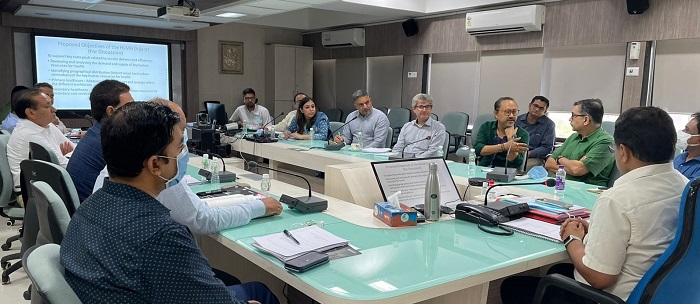The World Health Organization is supporting the Gujarat government to document the characteristics of the state’s health workforce in terms density, age, skill mix, geographical (rural and urban) distribution, migration trends, and performance in the public sector to inform policy decisions and develop a health workforce plan.
On 20 June 2022, Mr Manoj Aggarwal, Additional Chief Secretary and Commissioner, Health and Family Welfare, Government of Gujarat, led a team of additional directors at the state secretariat, officials from State Health System Resource Centre and IIPH-Gandhinagar met representatives from WHO India, SEARO, and HQ to discuss the priority areas and concerns to identify and analyze the key macro-economic factors that affect the health workforce development in the state.

Mr Manoj Aggarwal, Additional Chief Secretary, Health and Family Welfare, Government of Gujarat, leads the HLMA meeting for health workforce development in the state at New Sachivalaya (state secretariat), Gandhinagar
Since the private sector is a major healthcare provider in the State – including for-profit trust hospitals, NGOs and private clinics -- its modes of engagement under public-private partnerships extends the scope of this Health Labour Market Analysis (HLMA) exercise beyond its traditional focus of identifying supply and skill shortages to encompass labour market mismatches on access to care, health service performance and health worker well-being.
The relevance of HLMA approach was underscored by the COVID-19 pandemic that highlighted the importance of uninterrupted essential healthcare services provided by trained health workforce in adequate numbers for a well-functioning and resilient health system to tackle health emergencies.
Chhattisgarh was the first state in India for which the HLMA was designed and conducted in September 2018. The high vacancy rates of the health workforce and difficulty in retaining health personnel in hard-to-reach areas were the key concerns. The HLMA was jointly conducted by WHO with State Health Resource Centre and the Government of Chhattisgarh to amalgamate the evidence on health workforce bottle necks and identify the key elements for a successful rollout of Health and Wellness Centres. The process and outcomes of this HLMA and extent of the adoption of the policy recommendations were recently published.
The recommended actions were instrumental in assessing human resources for health policies for better recruitment, increased retention and rational deployment to improve skills and quality standards. It also documents the changes in the availability and distributional balances of the health workforce.
The Chhattisgarh experience has piqued the interest of the state governments of Assam and Gujarat, which have initiated the HLMA framework for UHC. Both governments have adopted a state-led approach in terms of ownership, engagement and collaboration, where each state has its own unique set of identified priorities, processes and existing policies.
The Health Labour Market Analysis Guidebook developed by WHO provides an overview of its key components and a toolkit devised for standardizing the guidance on the approach, dynamics, and analysis to support the countries in answering the key policy questions. It also derives from the state-level experiences from India and several other countries